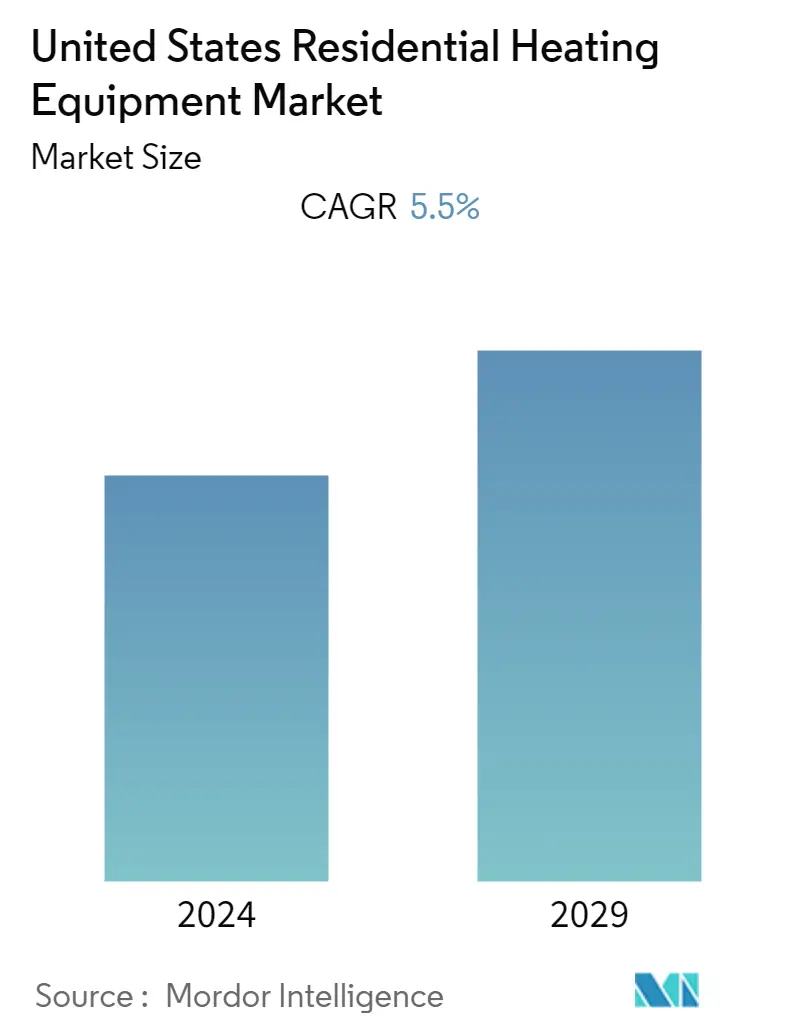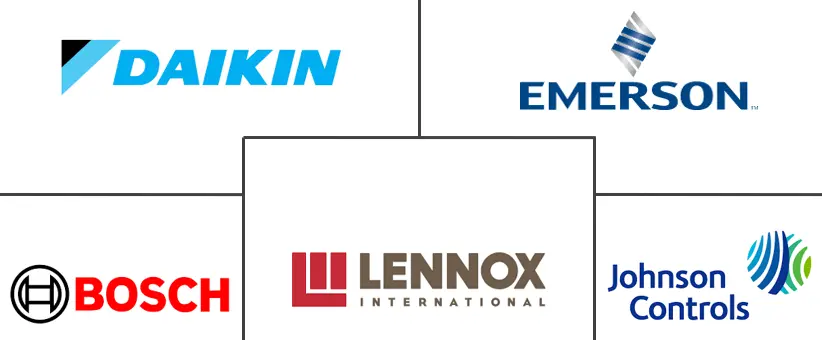Market Size of United States Residential Heating Equipment Industry

| Study Period | 2019 - 2029 |
| Base Year For Estimation | 2023 |
| Forecast Data Period | 2024 - 2029 |
| Historical Data Period | 2019 - 2022 |
| CAGR | 5.50 % |
| Market Concentration | Low |
Major Players
*Disclaimer: Major Players sorted in no particular order |
US Residential Heating Equipment Market Analysis
The United States Residential Heating Equipments Market is expected to register a CAGR of above 5.5%, during the forecast period (2022-2027). The growing demand for energy-efficient systems to reduce electricity bills and green building standards and codes is boosting the overall residential heating equipment market.
- Growing residential construction expenditure with increasing restructuring & replacement activities are predicted to boost heating equipment growth. The construction sector in the country is focused on developing sustainable and energy-efficient structures.
- The introduction of favorable regulatory policies and rebates for homeowners by policymakers in the country to integrate heating equipment and systems in their new houses are augmenting the demand for heating equipment. In addition, the rising energy consumption in the residential sectors is projected to drive the preference for technologically advanced residential heating equipment that reduces overall operational costs and improves energy savings.
- For instance, according to IEA, most heat pumps are installed in new buildings. In the United States, the share of heat pump sales for newly constructed buildings exceeds 40% for single-family dwellings and is near 50% for new multi-family buildings.
- The increasing need to curb dependence on fossil fuels and look for an energy-efficient alternative to the furnace is driving the demand for residential heating equipment over the forecast period. However, the availability of substitutes for this equipment and the cost of installation is hindering the growth of the market.
- The COVID- 19 pandemic has adversely affected the United States economy. Lockdowns across various states have resulted in the closure of multiple business activities and infrastructure development projects across the country. This has resulted in a decrease in demand for residential heating equipment.
US Residential Heating Equipment Industry Segmentation
Residential heating equipment includes furnace, air and water heater, heat pumps, and others that provide heat using electricity in the residential space for the purpose of ensuring the comfort of the occupants. The United States Residential Heating Equipment Market is segmented By Type (Furnace, Air and Water Heaters, Heat Pumps, Boilers).
United States Residential Heating Equipment Market Size Summary
The United States residential heating equipment market is poised for significant growth, driven by the increasing demand for energy-efficient systems and the adoption of green building standards. The market is experiencing a surge in residential construction activities, with a focus on sustainable and energy-efficient structures, which is expected to bolster the demand for heating equipment. Favorable regulatory policies and incentives for homeowners to integrate advanced heating systems in new constructions are further propelling market growth. The rising energy consumption in residential sectors is pushing consumers towards technologically advanced heating solutions that offer cost savings and improved energy efficiency. Despite challenges such as the availability of substitutes and installation costs, the market is set to expand, supported by the growing need to reduce reliance on fossil fuels.
The market landscape is characterized by a shift towards heat pumps, which are gaining popularity for their dual functionality in heating and cooling. The United States is a leading market for air source heat pumps, with consistent growth observed over the years. Government initiatives, such as the Department of Energy's focus on clean and efficient building systems and the extension of federal tax credits for heat pumps, are expected to enhance market adoption. The residential construction sector's recovery post-COVID-19, driven by demand for larger living spaces and limited housing inventory, is also contributing to the market's expansion. Key players in the industry are actively innovating and expanding their product offerings, further intensifying competition. The market's fragmentation is evident with major companies like Daikin Industries, Emerson Electric, and Robert Bosch continuously introducing new products and engaging in strategic activities to capture market share.
United States Residential Heating Equipment Market Size - Table of Contents
-
1. MARKET INSIGHTS
-
1.1 Market Overview
-
1.2 Industry Attractiveness - Porters Five Force Analysis
-
1.2.1 Bargaining Power of Suppliers
-
1.2.2 Bargaining Power of Buyers/Consumers
-
1.2.3 Threat of New Entrants
-
1.2.4 Threat of Substitutes
-
1.2.5 Intensity of Competitive Rivalry
-
-
1.3 Industry Value Chain Analysis
-
1.4 Assessment of Impact of COVID-19 on the Market
-
United States Residential Heating Equipment Market Size FAQs
What is the current United States Residential Heating Equipment Market size?
The United States Residential Heating Equipment Market is projected to register a CAGR of 5.5% during the forecast period (2024-2029)
Who are the key players in United States Residential Heating Equipment Market?
Daikin Industries Ltd., Emerson Electric Co., Robert Bosch LLC, Lennox International Inc. and Johnson Controls are the major companies operating in the United States Residential Heating Equipment Market.

